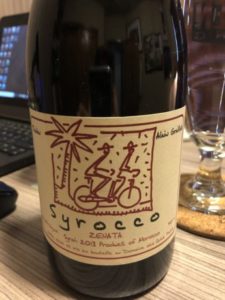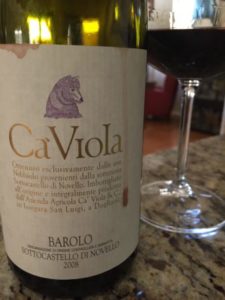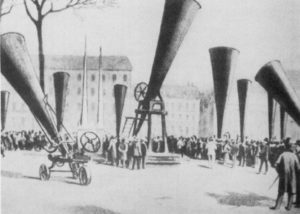Episode 166: Getting to Know Nebbiolo
We are getting to know Nebbiolo in June’s Grape Gab. Also, we deliberate a Burning Wine Question on knowing when to open your bottles versus saving them for future enjoyment.
In the Glasses: Morocco Syrocco & Nebbiolo

Steph: 2013 Moroccan Syrah called “Syrocco” from Domaine des Ouleb Thaleb

Val: 2008 Ca`Viola, Sottocastello di Novello, Barolo, Piemonte, Italia
June’s Grape Gab: Nebbiolo (4:38)
This is the highly appreciated grape that is responsible for the exceptional, long-lived wines of Barolo and Barbaresco. It is a mega-superstar in the wine world and its stardom even dates back to historical references in the 13th century.
And just in case you want to dig into a little more history:
What it Is (6:48)
Nebbiolo is a thin-skinned red grape originally from Piemonte and Valtellina, Italy. It tends to produce intense wines of high acidity, high tannins and high alcohol, despite it’s lighter color.
It’s name comes from the Italian word for “fog”, nebbia, which is usually present during the Fall in Piemonte. The fog blankets the Langhe hills and cools the vines with mist. But some also believe the white bloom that can be seen on the dark berry skins could also be a “fog” reference, or a reference to a nebula in the universe.
Where it Grows (9:00)
The majority of Nebbiolo (an estimated 95%) is grown in Northern Italy, mostly in Piemonte & about 15% in Lombardia (Italian Wine Central) and often used to make single-varietal dry red wines. Yet, it still only comprises not even 10% of the grapes grown in Piemonte.
Among the Vines (9:50)
In the vineyard, Nebbiolo can be vigorous and resistant to mildew. It is always the first to bud and the last to ripen, which can make it difficult from vintage to vintage. According to Steinberg (2006) in his Vines of San Lorenzo, Nebbiolo “needs all the sun it can get … [and] is more sensitive to site than any other fruit-bearing plant” (p. 24). It prefers, and is quite picky, calcareous marl and sandy soil types. Growers wait and wait and wait to pick, like late October and November, with daily fears of rain or hail.
What the Hail? (11:10)
Hail cannons – we mentioned them briefly, but they are – and have been – a thing for over 100 years. The Piemonte chapter in Bastianich & Lynch’s Vino Italiano actually begins with a story called “The Guns of Barbaresco!” Hail can absolutely decimate an entire harvest.
A Casa in Italia (at home in Italy) (11:38)
Nebbiolo is the noble grape of Piemonte. In this region you can find Nebbiolo in many of the red wines, from optional amounts to minimum in the blend specification, and then all the way to 100% Nebbiolo required by law.
There are too many designated areas to list, but the major ones are Barolo DOCG, Barbaresco DOCG, Gattinara DOCG, Ghemme DOCG, Nebbiolo d’Alba DOC, Langhe (Nebbiolo) DOC, and Roero DOCG. Check out ItalianWineCentral.com for a complete list and more.
Outside of Piemonte, Nebbiolo is found in the wines of
- Valle d’Aosta DOC
- Lombardia
- Valtellina Rosso DOC
- Valtellina Superiore DOCG
- Sforzato di Valtellina DOCG
- And there’s a small amount in the Luras, Gallura region on the island of Sardegna.
A Dirty Little Side Note (15:39)
We do dedicate three lousy minutes because we couldn’t help ourselves to dirt. It’s relevant because styles of Barolo and Barbaresco have been attributed to communes based on soils.
For example, in Barolo, there are more “feminine” examples, softer, more perfumed, from the La Morra and Barolo sites because of the blue, compact Tortonian marl in the Eastern Central Valley.
Yet, Serralunga d’Alba and Monforte d’Alba are generally signatures for a more full-bodied, power, structure and longer aging styles due to their Helvetian sandstone or Serravalian, red, iron-rich soils. These are the more “masculine” associations with the Barolo appellation.
Castiglione Falletto is also found in this western zone in the Serralunga Valley, but has some of the Tortonian marls and sands in its hills as well, so styles may vary.
The reason we went there was to give some of that nuance of its picky nature, AND how aging your wines come into play, which we’re talking about later.
Where Else in the World? (18:39)
Vine-growers are experimenting with Nebbiolo in North America (California, Oregon, Washington, Canada, Mexico), South America (Chile, Argentina), Europe (Austria, France, Switzerland, and even a splash on Italy’s island of Sardegna), Australia, New Zealand, and South Africa.
Bet you wouldn’t think Nebbiolo grows successfully in Arizona and Baja California, Mexico.
Oz Clarke, grape guru, gives a producer suggestion for US, such as Cavatappi in Washington; Mexico’s L A Cetto; and Australia’s Pizzini, for example.
Nebbiolo Name-Calling (21:00)
There are other names for the Nebbiolo grape that you may see on bottles, for example:
- Spanna in Piemonte
- Chiavennasca in Valtellina
- Picutener/Picotendro in Valle d’Aosta
Nebbiolo Clones (21:50)
There are three clonal variations of the Nebbiolo, including Lampia, Michet, and Nebbiolo Bolla.
Nebbiolo Rose’ was once thought to be a clonal selection, but has since been discovered to have a different DNA profile altogether.
In the Glass (22:43)
Val shuts the hell up for a minute while Steph lays out what happens in the glass. Ooh … Nebbiolo in the glass.
*moment of silence*
It is known for being perfumed and powerful “the king of wines, and the wine of kings.”
Visually, the wine looks relatively light, and with age it can take on an orange cast.
On the nose, Nebbiolo’s aromas stir your imagination and take you to fantasy land.
Barolo and Barbaresco wines are known for their scents of wild roses, truffles, tart red fruit, tobacco, eucalyptus, licorice, cinnamon, tar, violets, and dried plums.
Val has more issues than Time Magazine and continues to get pissed off about everything going on in her glass and in her mouth, by the way.
In the mouth, tannins are fierce and even with age, the best ones still put on a gun-show. Structurally it is an intense, pleasurable wine. All the parts – high acidity, high tannin, and high alcohol – come together with the fruity, savory and spicy flavors so perfectly and succinctly that the sum isn’t too “high” in anything.
But there are other styles too (25:05)
Nebbiolo grapes are dried to make the extremely special passito or Amarone-like style of wine called Sforzato di Valtellina.
It can also be used to make still rose’ wine (not to be confused with the Nebbiolo Rose’ grape) and savory, structured spumante/sparkling wines.
In fact, we tasted a beautiful Deltetto Pinot Noir/Nebbiolo blend classic method (metodo classico) sparkling wine last year, that Carlo Deltetto himself provided – still a fav!
Ageability of Nebbiolo (26:18)
Some producers make softer more accessible Nebbiolo single-varietal wines and blends. In Italy, these are often the classifications that are less strict such as the Langhe DOC or the Fara DOC that contains only 30-50% Nebbiolo in the blend.
Traditional Nebbiolos from Barolo and Barbaresco, as a general rule, should be aged a minimum of 10 years – with a caveat. If you open a bottle of Barolo too soon, when it’s too young, there’s a good chance you’re going to miss out on all the heady aromatics and interesting flavors. The wine will feel big in your mouth, but also feel closed and far away. Decanting and aerating it will help, but aging the wine is the preferred way to give it the respect it deserves.
Resources
Books:
Bastianich, J. & Lynch, D. (2005). Vino Italiano: The regional wines of Italy. New York: Clarkson-Potter.
Clarke, O. & Rand, M. (2010). Grapes and wines: A Comprehensive guide to varieties and flavours. New York: Sterling.
Robinson, J., & Harding, J. (2015). The Oxford companion to wine (4th ed). Oxford: Oxford University Press.
Robinson, J., Harding, J., & Vouillamoz, J. (2012). Wine grapes: A complete guide to 1,368 vine varieties, including their origins and flavours. New York: Ecco.
Steinberg, E. (2006). The vines of San Lorenzo: The making of a great wine in the new tradition. Barbaresco: Gaja.
Web:
GuildSomm.com
Italian Wine Central: https://italianwinecentral.com/variety/nebbiolo/
Burning Wine Question Segment (28:40)
Jennifer from North Carolina asks “Where is THE BEST site/app/FB Page/etc to find how long your unopened bottle of wine will last?”
There really is not just one site. Wines vary by producer and growing area. Best to check w/ producer, or regional experts (Bordeaux, Italy, Napa, etc.) if possible. We wish we had a one-stop-shop for you to check, but, we don’t.
Check the wine/producer’s website first. Sometimes the winemaker has recommendations. CellarTracker is one that Steph uses, as it has suggested drinking windows. Keep in mind, how the wine was stored is a factor in how well it will age.
Furthermore, something like 99%(ish) of all wine is made to be consumed right away. Not many age worthy wines last past 10 years either. “I tend to open and drink sooner than later. Maybe it’s impatience or the idea that we’re not promised another day” (wise words from Steph, an we’ll drink to that!).
Last piece of advice: check multiple resources to make your final conclusion – which is really your best guess.
Here are some general websites to check against.
Parker https://www.robertparker.com/resources/vintage-chart
WS (Members only content: http://www.winespectator.com/servefile/getfile/id/41618)
WE https://www.winemag.com/2018/01/22/2018-vintage-chart/
BBR https://www.bbr.com/vintages
Vivino https://www.vivino.com/wine-news/guide-to-aging-wine-why-and-when-to-age-wine
Final thought on this: Just because you CAN age a wine, does it mean you should?
Shoutouts: (35:30)
Our latest iTunes review from MixRx is titled “Great Wine Podcast”.
“These ladies know wine and share their knowledge in fun ways! I learned something & laughed during each episode I have experienced [2 thumbs up]”
Thank you for those five stars.
Speaking of stars …
Patreon Love (36:09)
Thank you to our Patrons who support us on our Patreon crowdfunding platform!
“Riserva Superiore Supporter”
- Robin from Girls Gone Grape
“Riserva Supporter”
- Antti in Georgia!
“TENacious Tasters”
- Jeff E from the award-winning We Like Drinking podcast
- Sebastian of Sassi Italy Tours
- Jen in Maryland (and the world, according to her Instagram feed)
- David and Lisa in Illinois
- Ann Marie in Virginia
“It’s not five o’clock and we don’t care” Listeners
- Meg in South Dakota
- Clay in Arizona
- In California – Jon, Andrew, Aswani
- Chantel in Ontario, Canada
- Mary Lou in Pennsylvania
- Cathie in Georgia
- In Colorado – Chris and Janet, Diane
- In Illinois – Steve, Renee
- Cathey in Tennessee
- Ashley in North Carolina
- Sean in Ohio
“Tastemaker Listeners”
- David in Scotland
- Carole in Kentucky
- Karen in California
- Chip & Karen in Pennsylvania
- Danielle
- Sirena in New York
Our Patreon page has details www.patreon.com/winetwofivepodcast on how to be entered into our monthly giveaway, exclusive content, and swag.
All Patrons at the $2/month or higher donation level are entered into the drawing.
Connect: (37:47)
There are other ways to support the show, including visiting our affiliate partners or shopping on Amazon!
Between each weekly chat you can find us on the social spaces @WineTwoFive, and we encourage you to join our private FaceBook group called Wine Two Five Community!
And Instagram!
Connect with Val on Twitter @WineGalUnboxed and everywhere else as @VinoWithVal.
Connect with Steph online as @TheWineHeroine.
Reminder: A Killer of a Book Club
#W25BookClub Announcement!
Tangled Vines : Greed, Murder, Obsession, and an Arsonist in the Vineyards of California, by Frances Dinkelspiel. This book was selected by our very first patron Meg in South Dakota, and she will be leading the book discussion in July. Stay tuned for that episode and go buy yourself (or borrow) the book. We all have plenty of time to indulge in the story and share some opinions.
It’s on Audible (www.audible.com), so you don’t even have to read it. You can walk, garden, drive, fold laundry, and listen!




